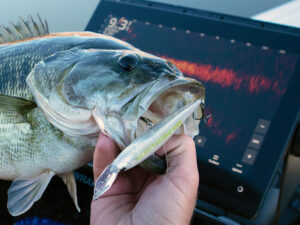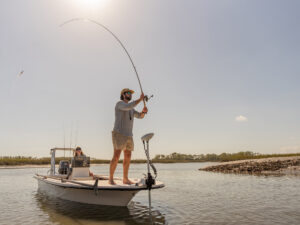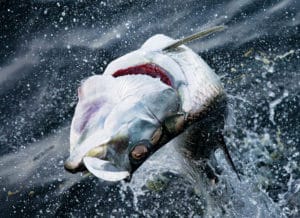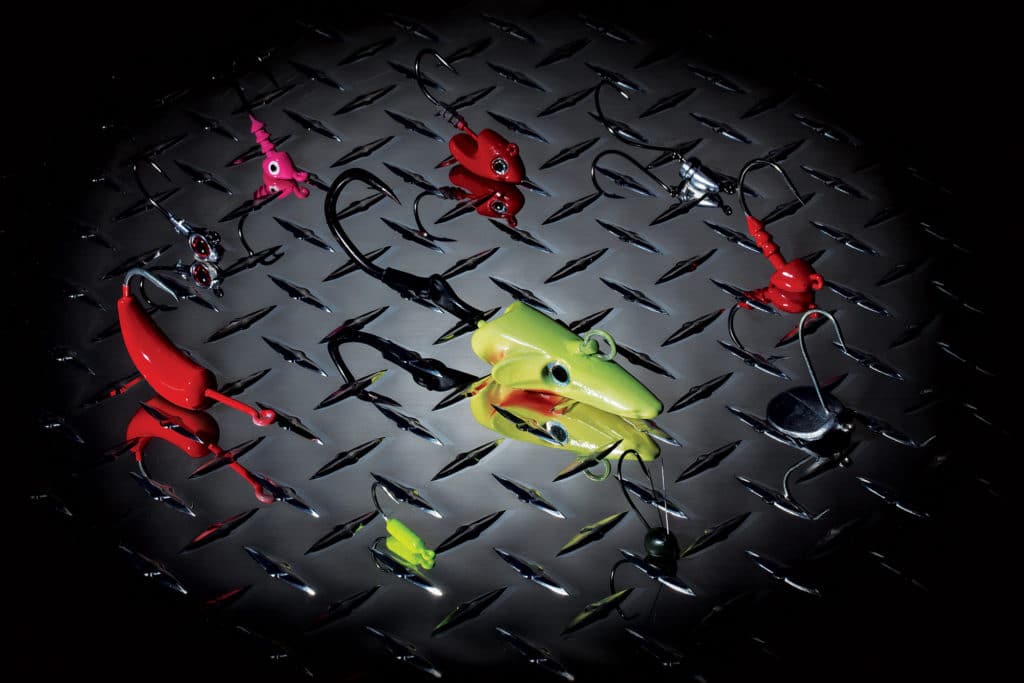
Football, bullet, shad, grub and boxing-glove heads — these common saltwater jig styles catch fish, period. Similarly, bucktail jigs (with natural or synthetic hairs) always make it into our tackle trays and onto our boats. But plenty of other types of fishing jig heads exist beyond the known commodities.
The same companies that produce common jig heads also manufacture lesser-known designs meant for specific fishing styles and techniques. Traditional jig heads fill the jack-of-all-trades role, but better options might be available for specific styles of fishing. Fish the grass flats regularly? Prefer to chin-weight your live baits? Cast soft baits for tuna or calico bass? There’s a jig head for you. Check out these 10 best saltwater jig head designs to consider adding to your tackle arsenal.
Almost Alive Weighted Swimbait Hook
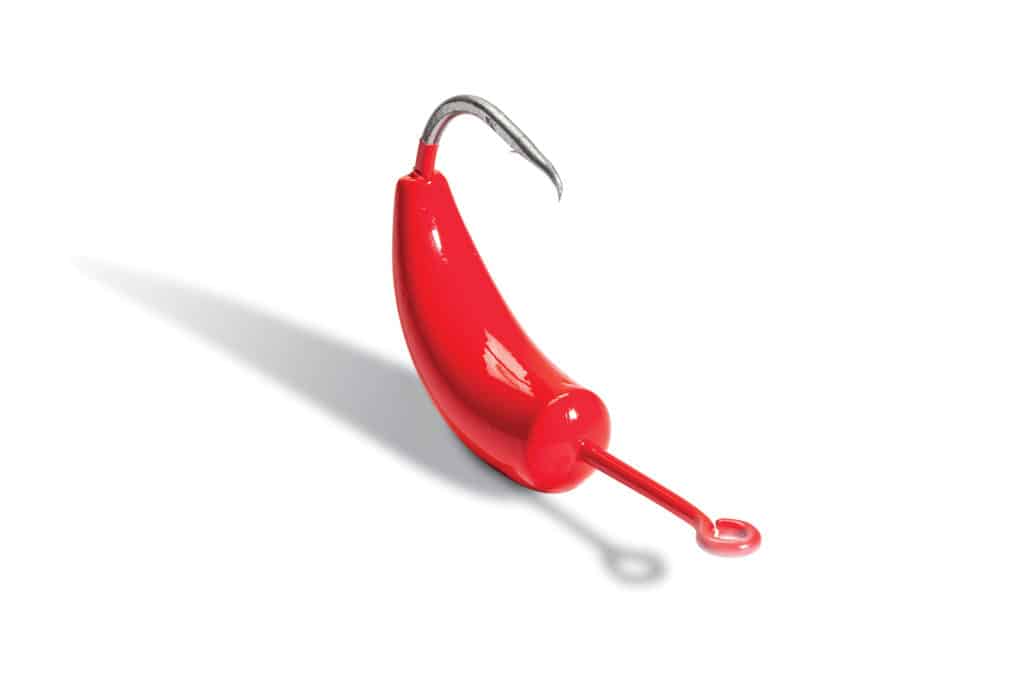
Application: The Almost Alive Weighted Swimbait Hook prevents baits from surface-skipping, holding the presentation subsurface when trolling. It’s great for king mackerel fishing with cigar minnows or pulling ballyhoo offshore, but just as useful as a heavy head in front of soft plastics when trolling or casting. The nose-rigged hook guides plastic baits in a natural swimming motion by controlling the lower jaw.
Unique Factor: Almost Alive sells two different styles of weighted hooks. One style features a fatter section of lead extending close to the barb for natural baits; the second style positions the fat section of the lead running toward the eye. Factory testing found the lead near the hook eye gives soft-plastic baits the optimal appearance and balance when trolling. Almost Alive soon expects to sell a much larger weighted hook, over 100 grams (3.5 ounces), for the largest soft baits on the market.
Berkley Gulp! Heads! Bait Delivery System
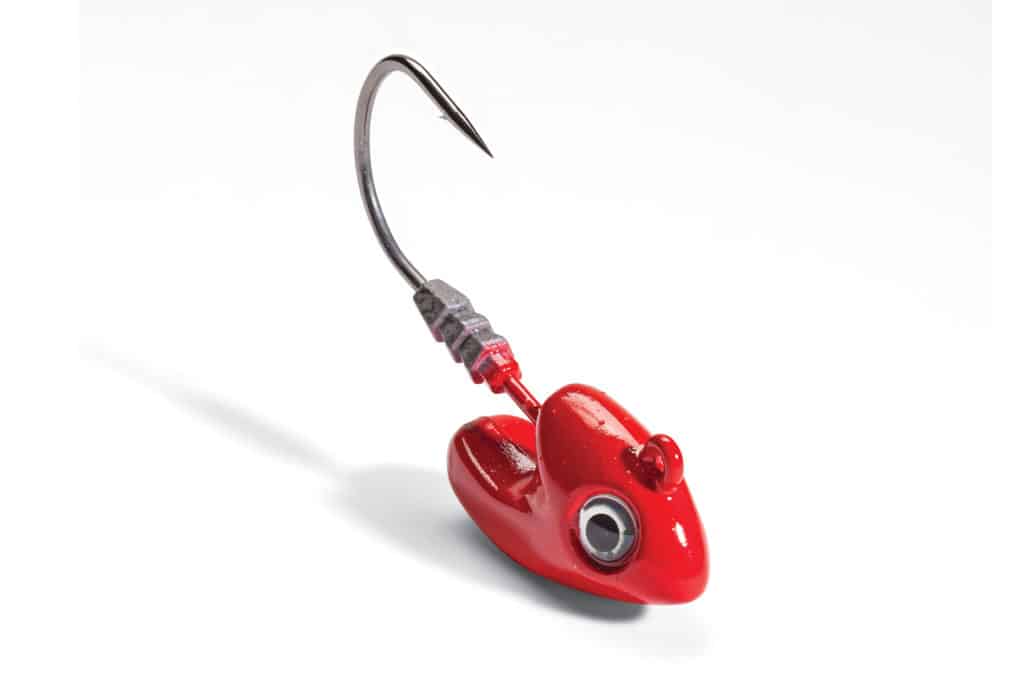
Application: The Bait Delivery System can be used in the same situations as a traditional jig head, such as over sandy flats, around oyster beds or next to structure. The jig maintains its horizontal profile as it descends on the drop, with help from keel-style and hook-shank weights. Whether fishing with Gulp! Shrimp for flounder, redfish and seatrout, or dropping on the nearshore reefs for grouper and snapper, the odd-looking jig attracts most inshore species to bite.
Unique Factor: The main advantage of the Bait Delivery System is the fall. BDS is designed to fall toward the bottom in a horizontal position rather than headfirst. This gives the jig and soft bait a different type of action. Made from a lead-free metal by Tundra, the BDS features a Grip Bait Keeper and realistic 3-D eyes.
Bomber Saltwater Grade Stand-Up Jig

Application: As waters cool down in wintertime, redfish, seatrout and flounder don’t react to soft baits as quickly as in spring or fall. During the cold months, anglers often get better and more hookups with jigs worked slowly. To attract less aggressive fish, a stand-up-style jig allows the bait to rest with the hook up. The Bomber Saltwater Stand-Up Jig features an angled, flat head that forces the hook and soft bait to stick out from the bottom.
Unique Factor: The angled, flat front of the jig allows the bait to settle on the bottom, with the soft bait and hook protruding off the bottom. Riding upward, the hook provides a natural, lethargic bait appearance and keeps the hook in position for a sure hook-set. The hook is premium black nickel.
Gamakatsu G-Finesse Jig Head Wacky

Application: Gamakatsu originally made the G-Finesse Wacky Jig for bass fishing “wacky”-style. Now saltwater anglers use the jig with soft plastics and live bait for a stealthy presentation. Live baits such as shrimp last longer on the light-wire hook compared to heavier gauges, plus the Wacky jig features a weed guard to deter hang-ups on the bottom. The Jig Head Wacky jig is a light-line finesse-type jig — not optimal as a power-fishing jig.
Unique Factor: The hook features a corrosion-resistant black-nickel finish and a weed guard made out of titanium (so it will always spring back into place). The light-wire hook penetrates fish such as seatrout and bonefish easily and keeps live baits alive longer.
Hogy Lures SI Harness Jig

Application: Built for vertical jigging, heavy casting or trolling, the Hogy Lures SI Harness Jig features a semi-stiff rig and ball-bearing swivel to deliver a straight line of pull, minimizing possible leverage from heavyweight fish intent on straightening the hook. Paired with big baits like the Hogy HDUV Eel Tail, the Harness jig is a threat for deep species such as grouper, when trolling up to 8 knots, or when casting for heavyweight tuna.
Unique Factor: One of the toughest jigs on the market today, the Harness jig is named after its 500-pound-test stainless-steel shrink-wrapped “harness,” which extends a VMC Barbarian hook away from the jig head. A 280-pound ball-bearing swivel is molded inside the jig and used as a line-tie. The sickle-shape hook penetrates through bone and cartilage.
Mustad Classic Yellowtail Snapper Jig Head
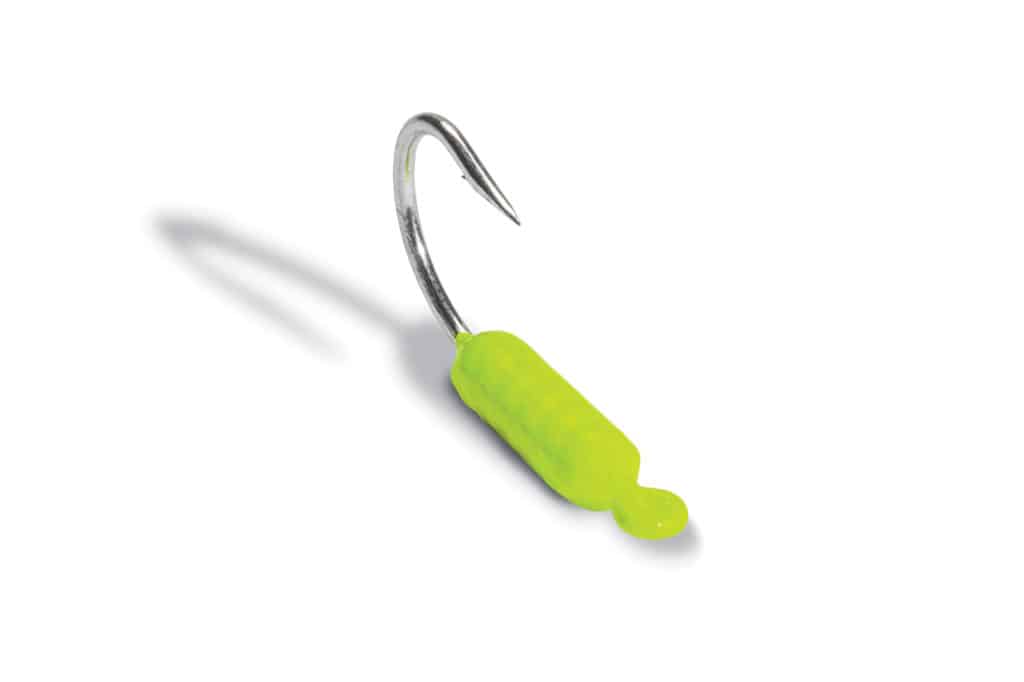
Application: When chumming over reefs for yellowtail snapper, pin live or strip baits to Mustad’s Classic Yellowtail Snapper Jig for an optimal sink rate. The lightweight jig, with a 1x short-bend hook (size 2 Mustad 7766D jig hook), drifts and falls like chum to the seafloor. Line-shy yellowtails have a hard time picking out hooked baits from chum in the chum line.
Unique Factor: The Yellowtail Snapper Jig Head is fishery-specific for hook-shy yellowtail snapper. The weight of the jig centers on the hook shank so it falls vertically to mimic a chum line. Jig models feature molded-in scale patterns in chartreuse, pearl or pink.
Owner Sled Head
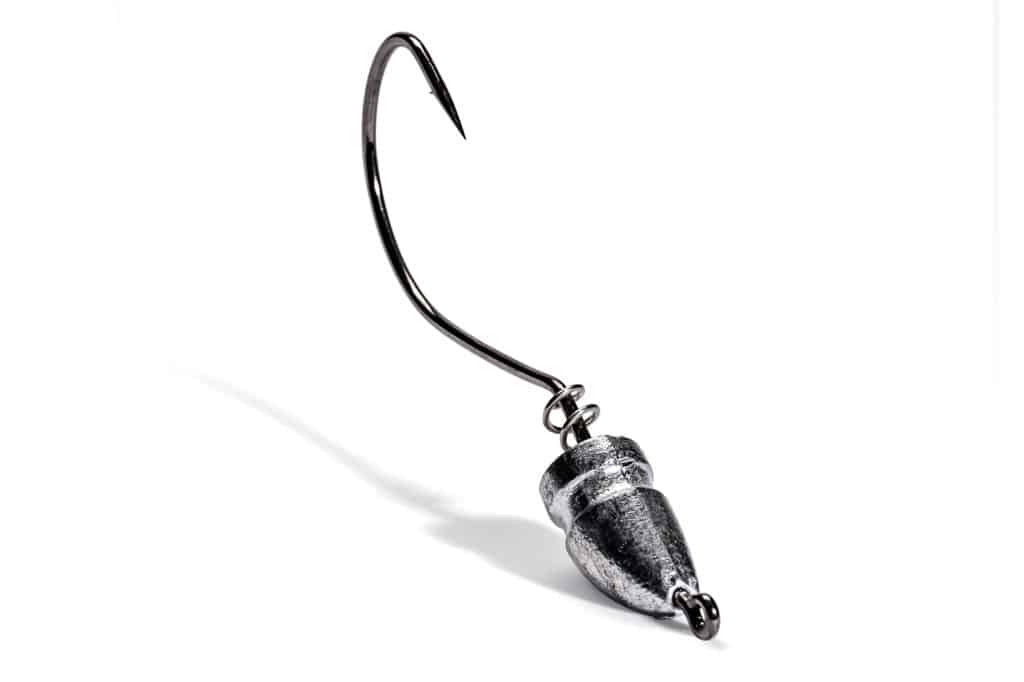
Application: Owner’s Sled Head is a mix of worm hook and jig head, ideal for grassy conditions such as fishing kelp in California or sargassum in open Gulf and Atlantic waters. Closer to shore, cast the Sled Head with a 7-inch jerkbait, rigged weedless near jetties and structure where snags are common. A variety of hook sizes and weights makes the Sled Head a versatile weedless jig head for saltwater.
Unique Factor: Features include a screw-lock keeper to hold plastics tight to the lead head. The shank design, similar to a worm hook, allows for completely weedless rigging to avoid snags. A large-wire hook handles heavy cover and braided fishing line.
Savage Gear 3-D Crab Stand-Up Jig Head

Application: The Savage Gear 3-D Crab Stand-Up Jig Head is designed specifically to rig with crab artificials, especially when a traditional jig head is too large or too heavy. With its upside-down mushroom appearance, the jig hides under crab baits such as Savage Gear’s PVC and TPE crabs. In fact, the detailing on the stand-up jig is designed to look just like a crab belly.
Unique Factor: A 3-D belly design and stand-up action are the key features of the 3-D Crab. The stand-up action of the jig head keeps the crab in a position with its claws up, mimicking a realistic defensive crab posture and enticing a bite.
VMC Swimbait Jig Head
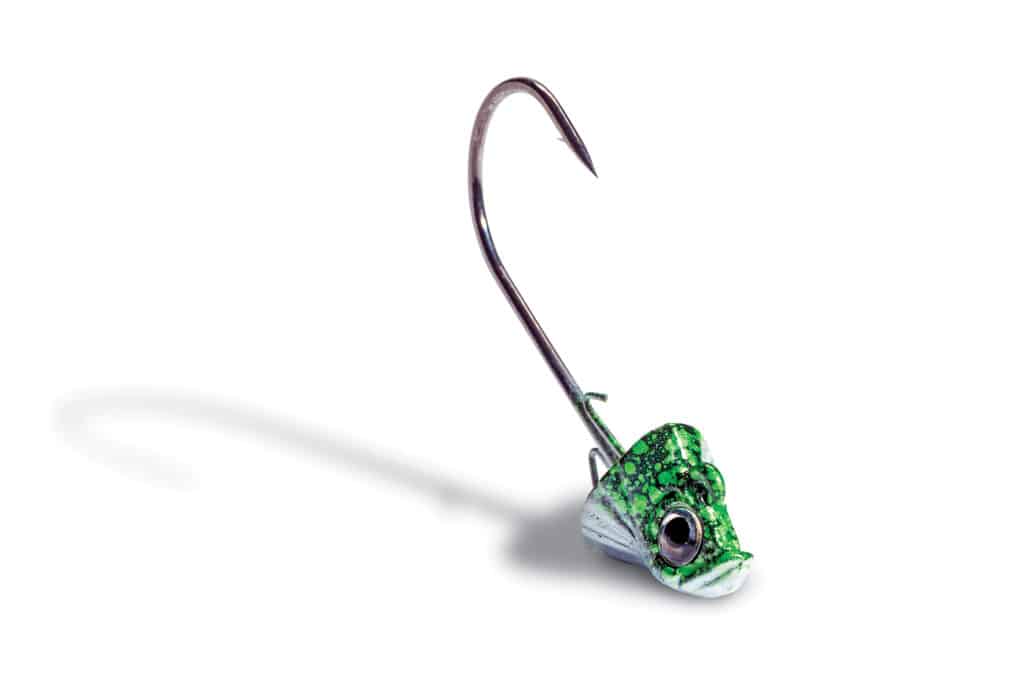
Application: Big-body paddle-tail swimbaits have their own jig head. VMC’s Swimbait Jig features a painted triangular concave head to handle most swimbaits. A pair of wire keepers holds baits snugly against the lead head. The swimbait is equally deadly casting to calico bass on the West Coast or striped bass on the East Coast.
Unique Factor: The VMC jigs were meant to take abuse. Designed to mimic a baitfish head, all jigs have painted flared gills and 3-D holographic eyes. They’re also equipped with a forged-shank, high-carbon steel, 1x-strong hook and double-wire keeper to ensure your bait stays connected.
Z-Man Trout Eye Jighead
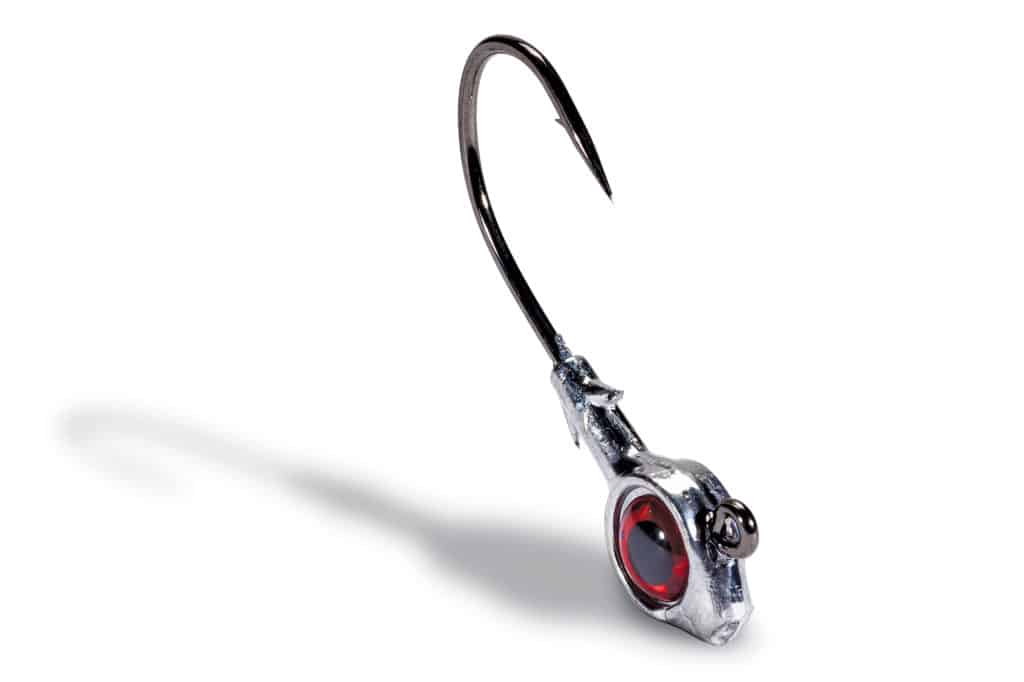
Application: Z-Man’s Trout Eye Jighead offers an attractive sink rate when matched to 3- to 5-inch inshore soft baits. The Trout Eye jig features a highly prominent eye and a 2/0 Mustad UltraPoint black-nickel hook. While the hook may appear small for saltwater species, it’s designed specifically to be closer to the eye, as predators often attack the eye instinctively. Targets include seatrout, redfish, snook and juvenile tarpon. Also, a great jig head for flounder.
Unique Factor: The Trout Eye jig was designed and developed by Charleston, South Carolina, seatrout guru Ralph Phillips. The most obvious feature is its oversize holographic eye, which takes up the majority of the jig. Phillips believes the eye causes a reaction strike from predator species.

